- About
Ancient City Discovered Underwater Solves Enigma That Puzzled Egyptologists For Years
http://cdn3.collective-evolution.com/assets/uploads/2013/12/map.jpg
An ancient Egyptian city found 6.5 km off of modern Egypt’s coastline reveals fascinating relics of Heracleion, also known as Thonis. The city’s ruins are located in Abu Qir Bay, originally existing near Alexandria, 2.5 km off the coast. Heracleion’s ruins span an area that is 11km by 15km – deservedly so considering the classical tale of Heracleion which was said to be a prosperous, brilliant, thriving city before it was engulfed by the sea around 1,500 years ago.

The ruins were first discovered by Franck Goddio using his unique survey-based approach that utilizes the most sophisticated technical equipment. In cooperation with the Egyptian Supreme Council of Antiquities, Oxford’s Centre for Maritime Archaeology and the Department of Antiquities of Egypt, Franck was able to locate, map and excavate several parts of the city.
Franck’s discovery accomplished many things including uncovering important information about the ancient landmarks of Thonis-Heracleion, such as the grand temple of Amun and his son Khonsou (Herakles for the Greeks), the harbours that once controlled all trade into Egypt, and the daily life of its inhabitants. Through his discovery he was able to solve a historic enigma that has baffled Egyptologists for years, that Heracleion and Thonis were actually the same city with two different names.
As you will see in the pictures, the relics recovered from the excavations boldly reveal the cities’ beauty and glory before it was buried by water. Anything from colossal statues, inscriptions and architectural elements, jewellery and coins, ritual objects and ceramics, were found and each reveals the opulence Heracleion experienced during its time. Many of the finds illustrate how crucial this city was to the ancient world economy. This is also seen by the huge amount of gold coins and bronze, lead and stone weights used to measure value of goods in ancient times. The importance of Heracleion has also been proved by the discovery of 64 ships, which is the largest number of ancient vessels ever found in one place. Along with these ships, a mind-boggling 700 anchors were found on the ocean floor.
The discoveries include a huge statue of the god Hapi, a statue of the classic Egyptian goddess Isis, a head of an unidentified Pharaoh and a number of smaller statues of Egyptian gods, figures and queens. Interestingly, dozens of sarcophagi containing the bodies of mummified animals sacrificed to Amun-Gereb were found. According to Egyptian history, Amun-Gereb is the supreme god of the Egyptians.
While it may not be the discovery of the coveted Atlantis, this discovery certainly has its own profoundness and beauty.

Colossus of a Ptolemaic queen made out of red granite. The whole statue measures 490 cm in height and weighs 4 tons. It was found close to the big temple of sunken Heracleion.
©Franck Goddio/Hilti Foundation, photo: Christoph Gerigk

Head of a colossal statue of red granite (5.4 m) representing the god Hapi, which decorated the temple of Heracleion. The god of the flooding of the Nile, symbol of abundance and fertility, has never before been discovered at such a large scale, which points to his importance for the Canopic region.
©Franck Goddio/Hilti Foundation, photo: Christoph Gerigk
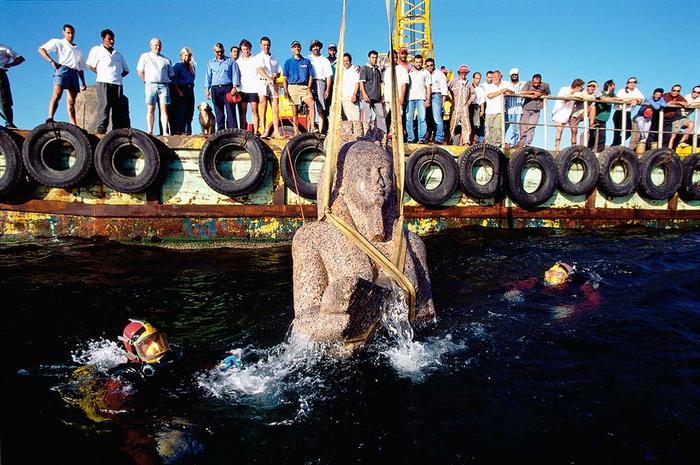
Franck Goddio and his team with a colossal statue of red granite (5.4 m) representing the god Hapi, which decorated the temple of Heracleion. The god of the flooding of the Nile, symbol of abundance and fertility, has never before been discovered at such a large scale, which points to his importance for the Canopic region.
©Franck Goddio/Hilti Foundation, photo: Christoph Gerigk

An archaeologist measures the feet of a colossal red granite statue at the site of Heracleion discovered in Aboukir Bay.
©Franck Goddio/Hilti Foundation, photo: Christoph Gerigk
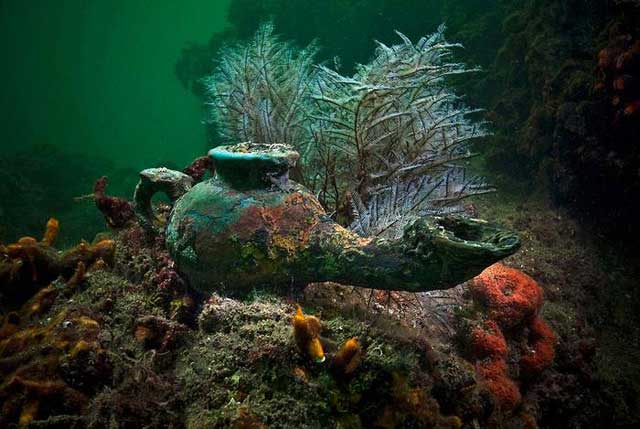
Bronze oil lamp (late Hellenistic period, about 2nd century BC) discovered in the temple of Amun.
©Franck Goddio/Hilti Foundation, photo: Christoph Gerigk

Franck Goddio with the intact and inscribed Heracleion stele (1.90 m). It was commissioned by Nectanebo I (378-362 BC) and is almost identical to the Naukratis Stele in the Egyptian Museum in Cairo. The place where it was to be situated is clearly named: Thonis-Heracleion.
©Franck Goddio/Hilti Foundation, photo: Christoph Gerigk

A gold vessel (Phiale) recovered from Thonis-Heracleion. Phiale were shallow dishes used throughout the Hellenistic world for drinking and pouring libations.
©Franck Goddio/Hilti Foundation, photo: Christoph Gerigk
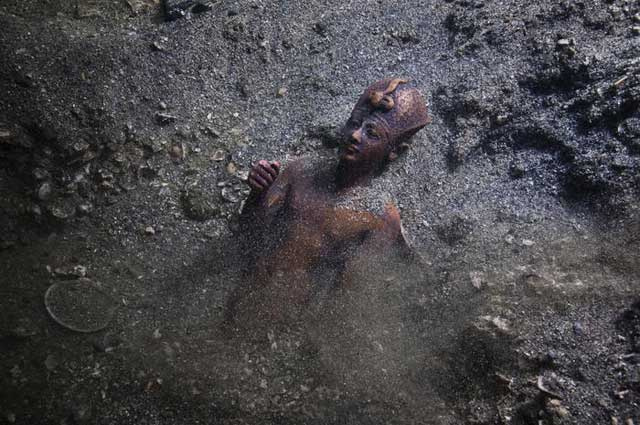
Bronze statuette of pharaoh of the 26th dynasty, found at the temple of Amon area at Heracleion. The sovereign wears the “blue crown” (probably the crown of the accession). His dress is extremely simple and classical: the bare-chested king wears the traditional shendjyt kilt or loincloth.
©Franck Goddio/Hilti Foundation, photo: Christoph Gerig
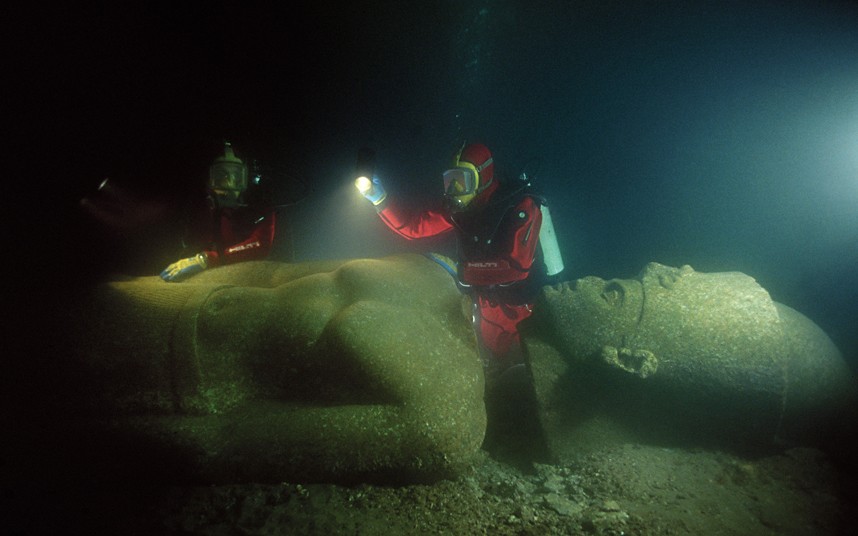
Franck Goddio and divers of his team are inspecting the statue of a pharaoh. The colossal statue is of red granite and measures over 5 metres. It was found close to the big temple of sunken Heracleion.
©Franck Goddio/Hilti Foundation, photo: Christoph Gerigk

Head of a pharaoh statue is raised to the surface. The colossal statue is of red granite and measures over 5 metres. It was found close to the big temple of sunken Heracleion.
©Franck Goddio/Hilti Foundation, photo: Christoph Gerigk
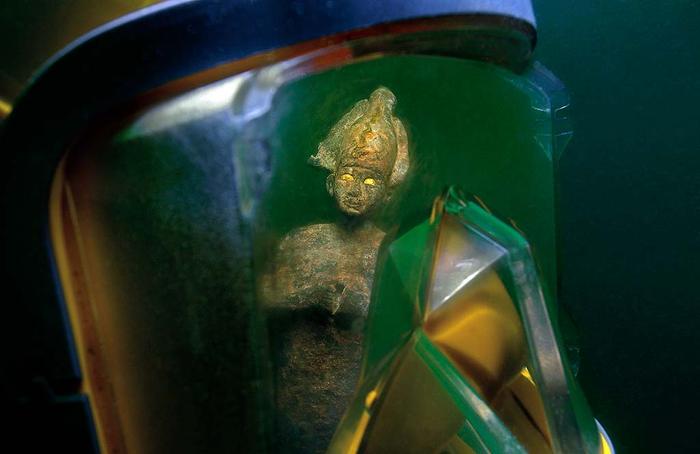
Bronze statue of Osiris, the assassinated and resurrected king-god. It is adorned with the atef crown. The typical insignia of power (crook and flail) are missing. Its open eyes are accentuated by fine gold sheets.
©Franck Goddio/Hilti Foundation, photo: Christoph Gerigk

The statue of the Goddess Isis sits on display on a barge in an Alexandrian naval base.
Sources
[url=http://www.thetimetravellers.org.uk/Egypts Lost City.pdf]http://www.thetimetravellers.org.uk/Egypts%20Lost%20City.pdf[/url]
http://www.franckgoddio.org/projects/sunken-civilizations/heracleion.html
Vía Collective-Evolution http://feedproxy.google.com/~r/Collective-evolution/~3/cwh-Ph-oerU/
Thanks to: http://peoplestrusttoronto.wordpress.com






 Sat Mar 23, 2024 11:33 pm by globalturbo
Sat Mar 23, 2024 11:33 pm by globalturbo

